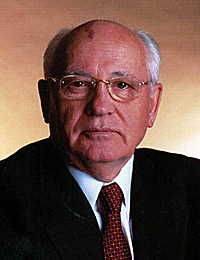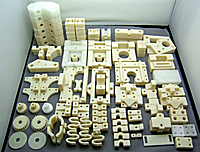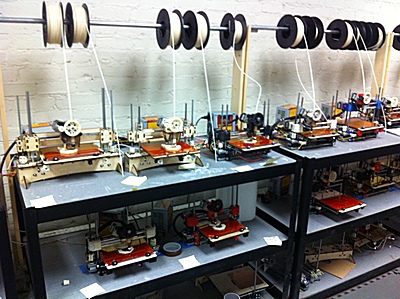As published in the
Washington Post 
(2009/06/07), with my own comments in
italics:

 Mikhail Gorbachev, former USSR leader, who ignited reformation which ultimately lead to fall of communism and the fall of the Berlin wall |
By
Mikhail Gorbachev 
Sunday, June 7, 2009
Years ago, as the Cold War was coming to an end, I said to my fellow leaders around the globe: The world is on the cusp of great events, and in the face of new challenges all of us will have to change, you as well as we. For the most part, the reaction was polite but skeptical silence.
In recent years, however, during speaking tours in the United States before university audiences and business groups, I have often told listeners that I feel Americans need their own change -- a perestroika, not like the one in my country, but an American perestroika -- and the reaction has been markedly different. Halls filled with thousands of people have responded with applause.
Over time, my remark has prompted all kinds of comments. Some have reacted with understanding. Others have objected, sometimes sarcastically, suggesting that I want the United States to experience upheaval, just like the former Soviet Union. In my country, particularly caustic reactions have come from the opponents of perestroika, people with short memories and a deficit of conscience. And although most of my critics surely understand that I am not equating the United States with the Soviet Union in its final years, I would like to explain my position.
Our perestroika signaled the need for change in the Soviet Union, but it was not meant to suggest a capitulation to the U.S. model. Today, the need for a more far-reaching perestroika -- one for America and the world -- has become clearer than ever.
It is true that the need for change in the Soviet Union in the mid-1980s was urgent. The country was stifled by a lack of freedom, and the people -- particularly the educated class -- wanted to break the stranglehold of a system that had been built under Stalin. Millions of people were saying: "We can no longer live like this."
We started with glasnost -- giving people a chance to speak out about their worries without fear. I never agreed with my great countryman Alexander Solzhenitsyn  when he said that "Gorbachev's glasnost ruined everything." Without glasnost, no changes would have occurred, and Solzhenitsyn would have ended his days in Vermont rather than in Russia.
when he said that "Gorbachev's glasnost ruined everything." Without glasnost, no changes would have occurred, and Solzhenitsyn would have ended his days in Vermont rather than in Russia.
At first, we labored under the illusion that revamping the existing system -- changes within the "socialist model" -- would suffice. But the pushback from the Communist Party and the government bureaucracy was too strong. Toward the end of 1986, it became clear to me and my supporters that nothing less than the replacement of the system's building blocks was needed.
We opted for free elections, political pluralism, freedom of religion and an economy with competition and private property. We sought to effect these changes in an evolutionary way and without bloodshed. We made mistakes. Important decisions were made too late, and we were unable to complete our perestroika.
Two conspiracies hijacked the changes -- the attempted coup in August 1991, organized by the hard-line opponents of our reforms, which ended up weakening my position as president, and the subsequent agreement among the leaders of Russia, Ukraine and Belarus to dissolve the Union. Russia's leaders then rejected the evolutionary path, plunging the country into chaos.
Nevertheless, when I am asked whether perestroika succeeded or was defeated, I reply: Perestroika won, because it brought the country to a point from which there could be no return to the past.
Putin's strong hand ruling Russia these days I won't consider Perestroika, but a turning it back to pre-Perestroika time, just with the difference to have sufficient funds from oil exports, a bit like China, capitalistic advantages are adapted, democratic reforms either rolled back or denied completely as in case of China. I'm well aware "democracy" isn't always the answer for all problems, the citizens require to understand this new given tool if never used, but such timespan should not extend longer than 5 years - and Putin as well China's communistic leaders are using way too much time to democratize their countries, and has become an empty promise.
In the West, the breakup of the Soviet Union was viewed as a total victory that proved that the West did not need to change. Western leaders were convinced that they were at the helm of the right system and of a well-functioning, almost perfect economic model. Scholars opined that history had ended. The "Washington Consensus," the dogma of free markets, deregulation and balanced budgets at any cost, was force-fed to the rest of the world.
But then came the economic crisis of 2008 and 2009, and it became clear that the new Western model was an illusion that benefited chiefly the very rich. Statistics show that the poor and the middle class saw little or no benefit from the economic growth of the past decades.
The current global crisis demonstrates that the leaders of major powers, particularly the United States, had missed the signals that called for a perestroika. The result is a crisis that is not just financial and economic. It is political, too.
The political crisis in the USA I don't see as such, of course the two party system of the US pretends to be an open democracy, but the economical one-sidedness of the culture developed also the democracy of the like: both parties are alike infiltrated by lobbyists, and true reforms aren't expected - except, Obama surprises us all.
The model that emerged during the final decades of the 20th century has turned out to be unsustainable. It was based on a drive for super-profits and hyper-consumption for a few, on unrestrained exploitation of resources and on social and environmental irresponsibility.
This is very true indeed, and its impact is widely negated in the western world.
But if all the proposed solutions and action now come down to a mere rebranding of the old system, we are bound to see another, perhaps even greater upheaval down the road. The current model does not need adjusting; it needs replacing. I have no ready-made prescriptions. But I am convinced that a new model will emerge, one that will emphasize public needs and public goods, such as a cleaner environment, well-functioning infrastructure and public transportation, sound education and health systems and affordable housing.
Elements of such a model already exist in some countries. Having rejected the tutorials of the International Monetary Fund, countries such as Malaysia and Brazil have achieved impressive rates of economic growth. China and India have pulled hundreds of millions of people out of poverty. By mobilizing state resources, France has built a system of high-speed railways, while Canada provides free health care. Among the new democracies, Slovenia and Slovakia have been able to mitigate the social consequences of market reforms.
The time has come for "creative construction," for striking the right balance between the government and the market, for integrating social and environmental factors and demilitarizing the economy.
Washington will have to play a special role in this new perestroika, not just because the United States wields great economic, political and military power in today's global world, but because America was the main architect, and America's elite the main beneficiary, of the current world economic model. That model is now cracking and will, sooner or later, be replaced. That will be a complex and painful process for everyone, including the United States.
Key aspect are the citizens, a top to down reformation I doubt will work, the masses themselves require to demand a reform and see the options. So, I see the educational aspect for providing suitable alternatives crucial, which themselves require also a shift in the thinking of people themselves, and such takes time, unless a crisis forces everyone to drop outdated ideas. Look at how Russia has a czar again in the figure of Putin, or China is still ruled by a monarchy, called "communistic party" . . . it is as if the citizens don't shift, the leaders just have new names and titles, but the system itself remains alike the past - only a superficial and non-lasting reform. In this context, your call for a perestroika reminds everyone also of its shortcomings of having a top down reformation where the citizens do not shift as fast or with a delay, and the system switches back to the past with new cloths.
My sincere hope is, Obama achieves a top down reformation which diffuses into the nation as whole, and not just a declared reformation which will be undone by a successor, but has a lasting effect.
However different the problems that the Soviet Union confronted during our perestroika and the challenges now facing the United States, the need for new thinking makes these two eras similar. In our time, we faced up to the main tasks of putting an end to the division of the world, winding down the nuclear arms race and defusing conflicts. We will cope with the new global challenges as well, but only if everyone understands the need for real, cardinal change -- for a global perestroika.
Mr. Gorbachev, I hope you are going to write a followup to point out more details of a Global Perestroika.
I consider the question about constant economical growth a key issue, and this aspect is a great taboo among all western societies, because the systems solely work on contant economical growth, which implies overproportional ecological problems like pollution of air, water and soil, the immediate environment we all rely on.
Even sustainability is the fashion term these years, it's hardly really understood at its depth - to have something sustainable its systemic cycle needs to be recognized: we cannot throw anything away, in essence everything comes back again, which also would imply a 100% recycle ratio of all products is required, and a pricing to reflect this. If this is not attained, the cycle is anyway there: trash and pollution comes back, in poisonous air, water and soil, where our food is grown from we eat again . . .
(Mikhail Gorbachev, the last general secretary of the Communist Party of the Soviet Union, heads the International Foundation for Socio-Economic and Political Studies  , a Moscow-based think tank).
, a Moscow-based think tank).























